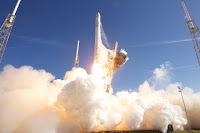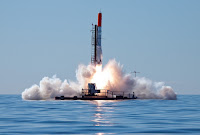"Space is not the final frontier - it is our next frontier"
I think the idea of building a ship based around the most well know Starship, the Enterprise is a great idea, it is what piqued my interest into reading more about it at http://www.buildtheenterprise.org/. I was expecting it to be a vague idea, but the person has put a fair bit of thought and research into this proposal. BTE Dan, is not suggesting that we build it right now, what he is suggesting that a feasibility study be undertaken to determine if it is indeed possible, with the current levels of technology that we have available to us today.
 |
| The 2020 Model of the Star Ship Enterprise Source http://www.buildtheenterprise.org/ |
At first I thought the idea of basing a modern star ship on TV series from 1966 was stupid, and then I realized that the reason I was reading the article was because of the name Enterprise and the association with Star Trek. I then realized that the man on the street isn't interested in thrust from rocket engines, or toilet systems of space ships, they need an idea that they can get behind, this may be that idea.
The American government over 40 years ago, with what could now be considered primitive computer power was able to launch a vehicle from earth, land on the moon and return safely, considering how far we have come with computing power and other technologies, we are ready to begin on a ship of this scale, it won't be easy, but nothing great comes easy.
I know this ship will never be built, or at least not that I will ever see. But I am excited by what is happening in the civilian space industry, and am hopeful that the idea of the Build the Enterprise will start more discussion and will get us one step closer to moving into space.
VIRGIN GALACTIC.
 Manned flight to 100 km for a few minutes of weightless and then back to earth. Backed by Billionaire Richard Branson. The first commercial space flight is expected to start this year, the first passengers will be Richard, and two of his children. Each trip will cost about USD $200,000 or you can buy all 5 available seats and take your mates for a million dollars.
Manned flight to 100 km for a few minutes of weightless and then back to earth. Backed by Billionaire Richard Branson. The first commercial space flight is expected to start this year, the first passengers will be Richard, and two of his children. Each trip will cost about USD $200,000 or you can buy all 5 available seats and take your mates for a million dollars.This will be the first space tourism company and currently has over 500 people paid up and booked ready to go to space. Interestingly this craft will not be approved to fly by the government and passengers will fly under informed consent, basically this means they sign a bit of paper that says this is a risky venture and I understand the risk, and that I am still willing to take this risk. This will not be like flying in an aircraft.
SPACE X
 Backed by Billionaire Elon Musk, of Tesla Car Company. Has 50 launches planned with over 4 Billion dollars in contracts from NASA and other space agencies. Their Falcon 9 recently launched and re-supplied the International Space Station in orbit.
Backed by Billionaire Elon Musk, of Tesla Car Company. Has 50 launches planned with over 4 Billion dollars in contracts from NASA and other space agencies. Their Falcon 9 recently launched and re-supplied the International Space Station in orbit.This is the commercial aspect of space travel, moving large loads of commercial equipment and supplies from the Earth to close orbit, similar to the private railways in America over one hundred years ago. Most (maybe all) of the SPACE X rockets are unmanned.
Copenhagen Suborbitals
Non profit, open source private space company run by Kristian vonBengtson to demonstrate that it can be done without the massive costs of other companies. This company is funded by donations from people like you and I.
I am probably most excited by this group as its open source, being done on a very limited budget of probably a few million where as the other two have budgets of Billions of dollars. I think any radical new space technologies are likely to come from here rather then the evolutionary nature of the other two, as they have the budgets to do things they way they are known of no, rather than having to come up with radical new break through solutions.



